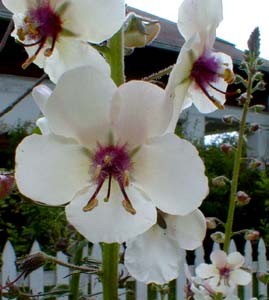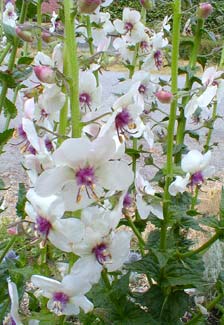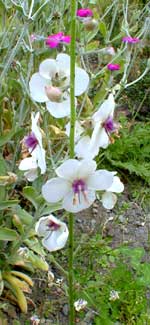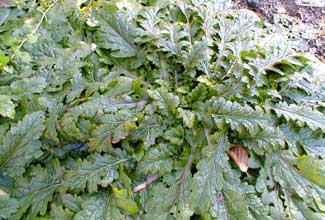
'Albiflorum'
Moth Mullein
"Oh, stony pasture,
Where the tall mullein
Stands up so sturdy
On its little seed!"
-Edna St Vincent Millay
(1892-1950)
(1892-1950)
The crinkly basal leaves of one-year-old Verbascum blattaria var albiflorum stay evergreen throughout winter & hug the ground so closely they in some cases appear pressed flat. I love its flat & simple appearance for its first year. About a third of them bloom their first year after having been seeded the previous summer or autumn, but the greater number remain only flat basal leaves & don't begin blooming in earnest until their second spring.
 The following spring, as it prepares its flower stems, this biennial hardly seems like the same plant at all. Sturdy leafy stems rise upright to three or four feet, occasionally a bit taller, which is quite tall despite that 'Albiflorum' is only a bit over half the size of the regular wild species.
The following spring, as it prepares its flower stems, this biennial hardly seems like the same plant at all. Sturdy leafy stems rise upright to three or four feet, occasionally a bit taller, which is quite tall despite that 'Albiflorum' is only a bit over half the size of the regular wild species.By late May & most powerfully by June, the whole length of the stem is studded with two-inch white flowers with furry purple stamens that resemble moth antennae, hence the common name Moth Mullein.
 Each blossom closes up at evening & reopens with the morning sun. They don't last well as cut flowers so should remain in the garden. It blooms throughout the summer, at least until August, with a few sporadic flowers still in September or early October, though as autumn approaches the flowering stems have fewer open blooms & more round seedpods the size of large peas.
Each blossom closes up at evening & reopens with the morning sun. They don't last well as cut flowers so should remain in the garden. It blooms throughout the summer, at least until August, with a few sporadic flowers still in September or early October, though as autumn approaches the flowering stems have fewer open blooms & more round seedpods the size of large peas.The flower-laden stalks sometimes need staking in their second year. Our original double-clump was more than strong enough to stand on their own for quite some while, but after a single heavy rainfall, they collapsed & needed to be stood up & braced, in this case with just a slender string that wrapped around two large clumps, anchored to the trunk of a young Rowan.
The species as a biennial wildflower has become naturalized throughout the majority of North America, & in some places is regarded as invasive. Such cloned cultivars as 'Albiflorum' are less aggressive & not so apt to escape far into the wild, though aggressive enough to seed itself throughout a cultivated area, to the point that it can become a pest if not weeded back a little.
Moth Mullein is hardy & easy to grow though naturally shortlived. It wants full sun, well-drained soil, & to say it is low maintenance is an understatement.
 'Albiflorum' invariably self-seeds, so that it need not die out of the garden; there will a dozen new plants (if not a hundred) for every clump that has completed its two-year life-cycle.
'Albiflorum' invariably self-seeds, so that it need not die out of the garden; there will a dozen new plants (if not a hundred) for every clump that has completed its two-year life-cycle.Deadheading the spent large stalks insures reflowering, but it's a good idea to let some of it go to seed so that even when the parent has reached the end of its biennial life, there'll be new ones appearing for the future. On the other hand, if it has become pesky in its self-seeding, the flower stalks should be deadheaded more vigorously before the last of the flowers on the stalk are finished, but before the green fruits have browned into ripened seeds.
Self-seeded youngsters sometimes but not invariably bloom the first year, but the return of those flattened leaves which last through the following winter is always of interest with or without summer flowering. The seedlings which do flower their first year are half to two-thirds the height of a mature specimen, slim-stemmed, with just a few but surprisingly showy blooms starting in late June or early July. Our initial two clumps died at the end of their second year, but the following year their offspring were everywhere, even in sidewalk cracks, in some cases forming a continuous weed-suppressing mat of overlapping leaf-rosettes pressed flat to the ground.
The third photo from June's end (2004) shows a self-seeded first-year stem pleasantly in bloom, rather dainty compared to the large clump it will become in its second year. The fourth photo is a January winter-evergreen portrait of the ground-hugging first-year leaf rosettes.